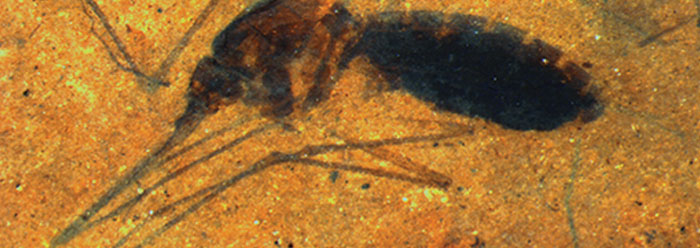by Brian Thomas, M.S., & Tim Clarey, Ph.D. *
A Blood-Filled Fossil
Researchers recently examined a spectacular mosquito fossil containing still-bloody remnants within its body. They dated the fossil based on the assumed age of the Kishenehn Formation where it was found, assigning it an age of 46 million years.1 Publishing in the Proceedings of the National Academy of Sciences (PNAS), the team used energy dispersive X-ray spectroscopy to confirm in triplicate the presence of iron and heme (blood pigments) inside the fossil mosquito’s abdomen, where living female mosquitos store their blood meals. The study authors wrote, “The combination of these two determinations indicates that the porphyrins [dark red pigments] are derived from the oxygen-carrying heme moiety of hemoglobin”—real blood.1
This mosquito’s abdomen, and likely its entire body, was never mineralized—i.e., replaced by minerals. Instead, it was preserved as a tiny carcass in a rock, called a compression fossil.1 Secular researchers have detected hemoglobin remnants like these in several other species, including tyrannosaur, hadrosaur, and mosasaur fossils.
These fossils pose a huge problem for evolutionary dating methods. Although a new study has shown that iron actually helps preserve dead nearby cells, no experiment has yet demonstrated a tissue decay rate that supports preservation over millions of years.2 Most longevity studies of biomolecules like hemoglobin, DNA, and collagen show decay rates in ranges that spell total disintegration of sterile samples from within a few months to several hundred thousand years, assuming reasonable Earth surface temperatures.3
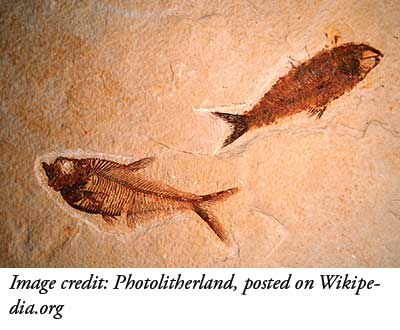 And there’s additional data to refute this old age assignment: The Kishenehn Formation also contains oil. If the rock is indeed millions of years old, then like blood’s heme pigments, oil’s organic, carbon-rich molecules should have completely degraded long ago—especially considering the voracious nature of oil-eating bacteria.4 Kishenehn oil contains heme from plant chlorophylls that also shouldn’t be there if the area is as old as the literature asserts.5 Even if bacteria were somehow kept from this oil for millions of years, it would still have fizzled into inorganic forms such as carbon dioxide, long before 46 million years elapsed.
And there’s additional data to refute this old age assignment: The Kishenehn Formation also contains oil. If the rock is indeed millions of years old, then like blood’s heme pigments, oil’s organic, carbon-rich molecules should have completely degraded long ago—especially considering the voracious nature of oil-eating bacteria.4 Kishenehn oil contains heme from plant chlorophylls that also shouldn’t be there if the area is as old as the literature asserts.5 Even if bacteria were somehow kept from this oil for millions of years, it would still have fizzled into inorganic forms such as carbon dioxide, long before 46 million years elapsed.
Conflict of the Ages
The authors of the mosquito paper wrote, “The data reported herein provide incontrovertible documentation of the presence of heme- and arguably hemoglobin-derived porphyrin in a 46-million-year-old compression fossil and localize the porphyrins to a specific anatomical structure within that fossil.”1 Yet, while they did directly measure the blood elements, they did not directly measure the fossil’s age.
How can one resolve the conflict between real protein’s maximum inferred age limit of thousands of years and the fossil protein’s age assignment of millions of years? Examining the fossil age-dating procedure that these secular scientists used tells an informative story. The authors cited a previously published age assigned to the Kishenehn Formation where the mosquito fossil was found rather than doing an independent or objective test of the fossil’s age.
Embarrassing Radioisotope Results
The geological publication the study authors cited actually listed two ages for the relevant layers within the Kishenehn: 46.2+0.4 and 43.5+4.9 million years.6 Why the PNAS authors chose 46 million over 43 million is anyone’s guess since they offered no explanation in their report.
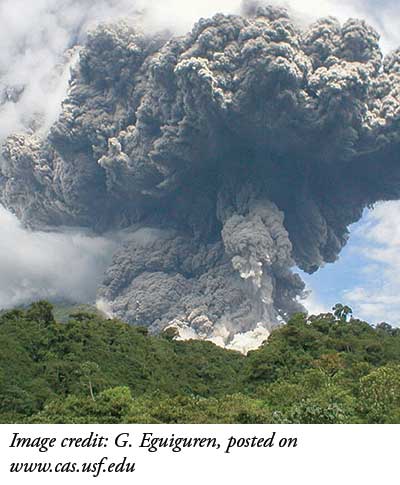 Radioisotope dating involving argon decay provided the older of the two ages. Argon-argon dating methods begin by measuring relative amounts of argon isotopes—or versions of an element with different masses—in an igneous rock sample. Though the Kishenehn is largely sedimentary, it does contain volcanic ash called tephra that holds argon. Researchers generated age estimates after assuming 1) that no argon isotopes had entered or escaped the tephra since it was deposited and 2) that all of the originally deposited argon was of the parent isotope and that the sample originally had none of the daughter isotope (the heavier parent decays into the lighter daughter).
Radioisotope dating involving argon decay provided the older of the two ages. Argon-argon dating methods begin by measuring relative amounts of argon isotopes—or versions of an element with different masses—in an igneous rock sample. Though the Kishenehn is largely sedimentary, it does contain volcanic ash called tephra that holds argon. Researchers generated age estimates after assuming 1) that no argon isotopes had entered or escaped the tephra since it was deposited and 2) that all of the originally deposited argon was of the parent isotope and that the sample originally had none of the daughter isotope (the heavier parent decays into the lighter daughter).
Data from several unrelated studies have debunked the second assumption, showing that argon-based radioisotope dating methods don’t work and offering a reason why. For example, one geologist reviewed 23 studies of rocks of historical ages. The exact year each rock formed was known. Yet, 23 out of 23 rocks rendered “excessively old K-Ar ‘ages’” when tested.7 The radioisotope ages were orders of magnitude above the rocks’ actual ages. What caused this systemic problem? Extra argon had entered the hardening volcanic rocks from sources other than radioisotope decay. Thus, scientists who assumed that the ratios depended entirely on radioactive decay saw the rocks as far older than they really were.
An illustration might clarify the issue. Suppose scientists developed a method to determine a person’s age by comparing the relative numbers of their gray and colored hairs. They would probably first standardize hair ratios to ages in years. Finding extra argon in these volcanic rocks is like discovering that some process other than aging (severe emotional trauma, for instance) adds extra gray hairs. Like so many gray-haired twenty-somethings, volcanic rocks can be argon-rich and yet quite young.
These argon-based methods have failed in the past. Why should they be trusted in this case? Could a separate dating technique confirm the Kishenehn Formation’s argon-based ages? Researchers already tried this, deriving a uranium-based date from the same region within the Kishenehn Formation that yielded a much younger age of only 33.2+1.5 million years.8
Finding discordant radioisotope dates is nothing new. In 1986, another geologist described radioisotopes in England: “Although the problems of loss of daughter product are far less severe in the 87Rb-87Sr method than in 40K-40Ar dating, they do as shown, still exist. Even in igneous rocks, discordant mineral dates are more often encountered than concordant dates.”9 And not just a little discordant. Just like some of the attempts at dating the Kishenehn Formation, separately obtained ages often lie far outside each other’s error margins.
If radioisotope dating really worked, then its different isotope systems would align with one another and with known ages when used on the same rock. But it doesn’t.
Fossil “Ages” to the Rescue?
Since isolated radioisotope results cannot be trusted to provide accurate ages, secular scientists add more steps to the process of age-dating rocks and fossils. By what means do they select different date options? Typically, they correlate the fossils in the rock layer to a chart showing rock layers with numbered ages printed alongside fossil descriptions. They then select ages that match those printed on the chart where the described fossils appear.
For example, one paper reported that the Kishenehn Formation “contains a fauna of nonmarine mollusks [freshwater clams] and mammals, the latter permitting an age assignment to the Early Oligocene or Late Eocene”—“ages” that range from 28 to 38 million years ago.10
After petroleum geologist Patrick Monahan studied the area’s geology, he wrote,
The Kishenehn Formation has a diverse fauna and flora that suggests a range of ages between late Eocene and early Miocene. However, a fission track age of 33.2+1.5Ma in the lower member in the Kishenehn Basin, and a K/Ar date of 29.9+5.3Ma in similar strata in a nearby basin indicate that the lower part of the Kishenehn is early to middle Oligocene.11
Mixed Messages
None of these age options match the PNAS article’s designation of 46 million years, which corresponds to a Middle Eocene age on the evolutionary fossil chart. Is the lower member of the Kishenehn Formation—the section that has a mosquito fossil with blood proteins—46, 43, 33, 30 million years old, or none of the above? Was it deposited during the Eocene, the later Oligocene, or the still-later Miocene? Secular geologists don’t seem too sure.
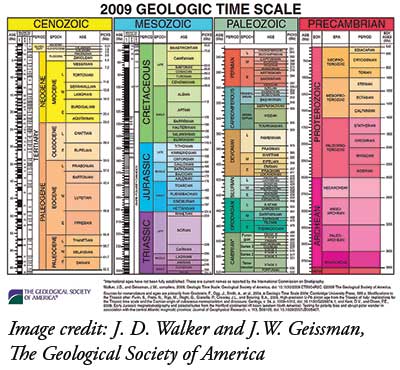 They are certain, however, that standardized fossil and rock layer charts represent real, historical epochs lasting thousands or millions of years.12 Nevertheless, the evidence does not demand or even fit this concept, which arose centuries ago during the Enlightenment. European naturalists decided that the reason different kinds of fossils are found in different rock layers is because those creatures lived and died in different, ancient eras.13,14 In other words, their certainty rests merely on the assumption that fossils were deposited during separate time eras rather than deposited in separate areas at a similar time.
They are certain, however, that standardized fossil and rock layer charts represent real, historical epochs lasting thousands or millions of years.12 Nevertheless, the evidence does not demand or even fit this concept, which arose centuries ago during the Enlightenment. European naturalists decided that the reason different kinds of fossils are found in different rock layers is because those creatures lived and died in different, ancient eras.13,14 In other words, their certainty rests merely on the assumption that fossils were deposited during separate time eras rather than deposited in separate areas at a similar time.
There is another explanation that does a better job of accounting for fossil distributions. In this scenario, each layer represents a tsunami-like wave that inundated and then deposited plants and animals from particular ecosystems, not from particular times. This idea is consistent with the presence of at least some modern-looking plants and animals in most of these layers and supports the layering structures shown by fast-flow sediment modeling experiments.15
Rounding It Out
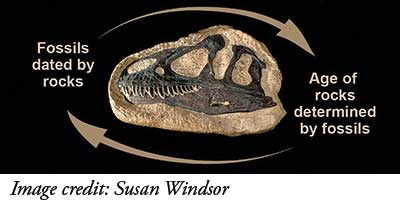 In review, how was the bloody mosquito fossil’s age set to 46 million years? First, the study authors simply cited what other researchers had said about the Kishenehn Formation’s age. And how did those others obtain an age? By matching the fossils in the rock unit to those described on the geologic chart that assigns age ranges to fossils. At some point, radioisotope ages were selected that matched the fossil’s charted, evolutionary age range. This way, a separate technique gave the appearance of independent confirmation. Finally, how did they know that those organisms lived in long-ago eras? Because secular scientists have taught generations of students that rock layers correspond to eons that lasted millions of years. Like so many dating procedures, this one merely concludes with what it assumed in the beginning.16
In review, how was the bloody mosquito fossil’s age set to 46 million years? First, the study authors simply cited what other researchers had said about the Kishenehn Formation’s age. And how did those others obtain an age? By matching the fossils in the rock unit to those described on the geologic chart that assigns age ranges to fossils. At some point, radioisotope ages were selected that matched the fossil’s charted, evolutionary age range. This way, a separate technique gave the appearance of independent confirmation. Finally, how did they know that those organisms lived in long-ago eras? Because secular scientists have taught generations of students that rock layers correspond to eons that lasted millions of years. Like so many dating procedures, this one merely concludes with what it assumed in the beginning.16
Secular fossil dating procedures involve complicated loops of circular reasoning. This fossil mosquito with partly decayed blood proteins in its abdomen is not 46 million years old—decay tests clearly indicate this is astronomically unlikely. Its secular age assignment was hand-picked to conform to a deeply entrenched, millions-of-years belief system.
The fossil blood heme pigments look much younger than that, as do the oil and plant heme pigments within the Kishenehn Formation. The central challenge to secular science therefore remains: Could blood really persist for millions of years? Empirical science would say that there’s just no way.
References
- Greenwalt, D. E. et al. 2013. Hemoglobin-derived porphyrins preserved in a Middle Eocene blood-engorged mosquito. Proceedings of the National Academy of Sciences. 110 (46): 18496-18500.
- Schweitzer, M. H. et al. A role for iron and oxygen chemistry in perserving soft tissues, cells and molecules from deep time. Proceedings of the Royal Society B. Published online before print November 27, 2013.
- Thomas, B. 2013. A Review of Original Tissue Fossils and Their Age Implications. Proceedings of the Seventh International Conference on Creationism. Horstemeyer, M., ed. Pittsburgh, PA: Creation Science Fellowship.
- Clarey, T. 2013. Oil, Fracking, and a Recent Global Flood. Acts & Facts. 42 (10): 14-15.
- Curiale, J. A. and S. W. Sperry. 1987. Regional Source Rock Potential of Kishenehn Formation, Northwest Montana. Search and Discovery Article #91038. American Association of Petroleum Geologists. AAPG Annual Convention, Los Angeles, California, June 7-10.
- Ar40/Ar39 ratios from 12 biotite grains yielded the 46.2-million-year age, and fission track analysis of uranium decay from seven zircon crystals showed a 43.5-million-year age. See Constenius, K. N. 1996. Late Paleogene extensional collapse of the Cordilleran foreland fold and thrust belt. Geological Society of America Bulletin. 108 (1): 20-39.
- Snelling, A. A. 1999. “Excess Argon”: The “Archilles’ Heel” of Potassium-Argon and Argon-Argon “Dating” of Volcanic Rocks. Acts & Facts. 28 (1).
- Constenius, K. N. et al. 1989. Reconnaissance paleontologic study of the Kishenehn Formation, northwestern Montana and southeastern British Columbia. In French, D. E. and R. F. Grabb, eds. Montana Geological Society: 1989 Field Conference Guidebook, Montana Centennial Edition. Vol. 1. Billings, MT: Montana State University, 189-203.
- Durrance, E. M. 1989. Radioactivity in Geology. Chichester, UK: Ellis Horwood Ltd., 441. Cited in Woodmorappe, J. 1999. The Mythology of Modern Dating Methods. El Cajon, CA: Institute for Creation Research, 28.
- Russell, L. S. 1964. Kishenehn Formation. Bulletin of Canadian Petroleum Geology. Special Guide Book Issue: Flathead Valley. 12 (2S): 536.
- Monahan, P. A. 2000. The Geology and Oil and Gas Potential of the Flathead Area, Southeastern British Columbia. Petroleum Geology Special Paper 2000-2. Brentwood Bay, BC: Monahan Petroleum Consulting.
- The rock layers are real, but their assigned time ranges are not. See Austin, S. A. 1984. Ten Misconceptions about the Geologic Column. Acts & Facts. 13 (11).
- Cuvier, G. and E. Griffith. 1830. The Fossil Remains of the Animal Kingdom. London: Whittaker, Treacher, and Co.
- Linking Earth layers to epochs generates severe problems, such as how to get oceans to repeatedly cover continents and how to preserve labile carcasses as fossils in a slow-and-gradual context.
- Berthault, G. 2000. Experiments in Stratification. Acts & Facts. 29 (10).
- “By assuming naturalism and uniformitarianism, the critic has already merely assumed that the Bible is wrong. He then uses this assumption to conclude that the Bible is wrong. His reasoning is circular.” See Lisle, J. 2010. Discerning Truth. Green Forest, AR: Master Books, 24.
Image credit: PNAS
* Mr. Thomas is Science Writer and Dr. Clarey is Research Associate at the Institute for Creation Research.




